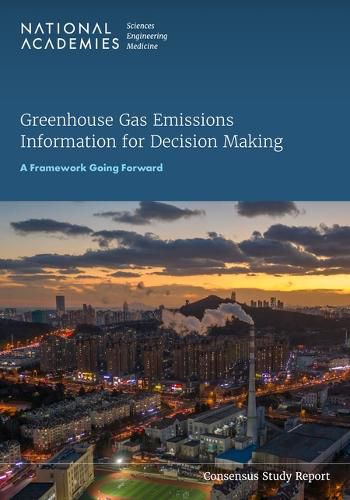Greenhouse Gas Emissions Information for Decision Making
National Academies of Sciences, Engineering, and Medicine, Division on Earth and Life Studies, Board on Atmospheric Sciences and Climate, Committee on Development of a Framework for Evaluating Global Greenhouse Gas Emissions Information for Decision Making

Greenhouse Gas Emissions Information for Decision Making
National Academies of Sciences, Engineering, and Medicine, Division on Earth and Life Studies, Board on Atmospheric Sciences and Climate, Committee on Development of a Framework for Evaluating Global Greenhouse Gas Emissions Information for Decision Making
Climate change, driven by increases in human-produced greenhouse gases and particles (collectively referred to as GHGs), is the most serious environmental issue facing society. The need to reduce GHGs has become urgent as heat waves, heavy rain events, and other impacts of climate change have become more frequent and severe. Since the Paris Agreement was adopted in 2015, more than 136 countries, accounting for about 80% of total global GHG emissions, have committed to achieving net-zero emissions by 2050. A growing number of cities, regional governments, and industries have also made pledges to reduce emissions. Providing decision makers with useful, accurate, and trusted GHG emissions information is a crucial part of this effort.
This report examines existing and emerging approaches used to generate and evaluate GHG emissions information at global to local scales. The report develops a framework for evaluating GHG emissions information to support and guide policy makers about its use in decision making. The framework identifies six criteria or pillars that can be used to evaluate and improve GHG emissions information: usability and timeliness, information transparency, evaluation and validation, completeness, inclusivity, and communication. The report recommends creating a coordinated repository or clearinghouse to operationalize the six pillars, for example, by providing timely, transparent, traceable information; standardized data formats; and governance mechanisms that are coordinated, trusted, and inclusive of the global community.
Table of Contents
Front Matter Summary 1 Introduction 2 Current Approaches for Quantifying Anthropogenic Greenhouse Gas Emissions 3 Structural and Technical Limitations of the Current Greenhouse Gas Emissions Information Landscape 4 Framework for Evaluating Greenhouse Gas Emissions Information 5 Recommendations References Appendix A: Acronyms, Initialisms, and Glossary Appendix B: Atmospheric Observations: Methods and Examples Appendix C: Contributors of Input to the Study Appendix D: Biographical Sketches of Committee Members Appendix E: Disclosure of Unavoidable Conflicts of Interest
This item is not currently in-stock. It can be ordered online and is expected to ship in approx 4 weeks
Our stock data is updated periodically, and availability may change throughout the day for in-demand items. Please call the relevant shop for the most current stock information. Prices are subject to change without notice.
Sign in or become a Readings Member to add this title to a wishlist.


